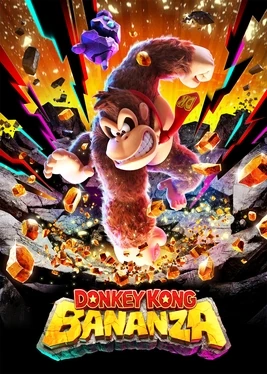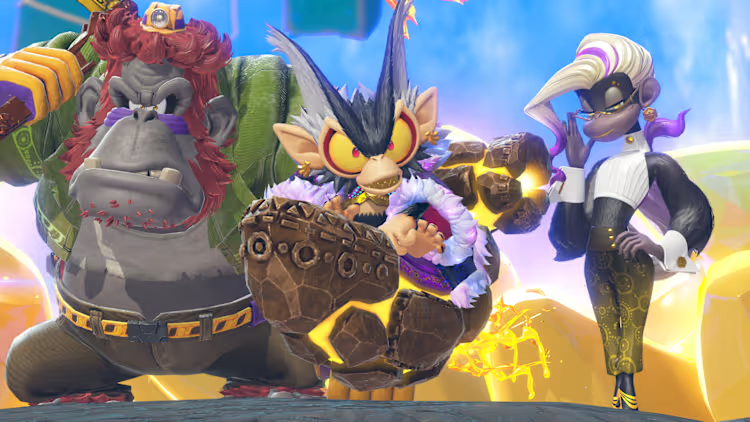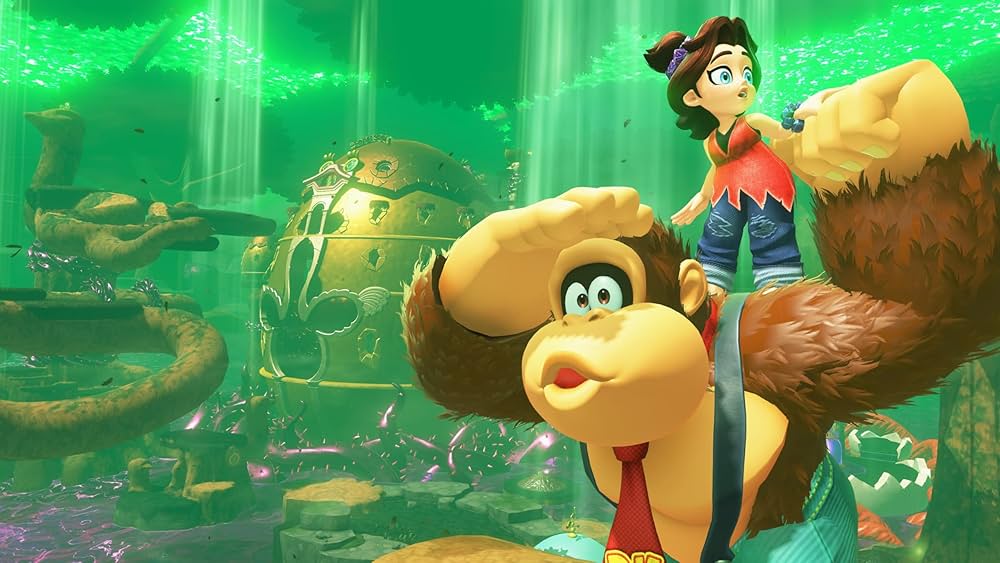Search
[{{{type}}}] {{{reason}}}
{{/data.error.root_cause}}{{{_source.title}}} {{#_source.showPrice}} {{{_source.displayPrice}}} {{/_source.showPrice}}
{{#_source.showLink}} {{/_source.showLink}} {{#_source.showDate}}{{{_source.displayDate}}}
{{/_source.showDate}}{{{_source.description}}}
{{#_source.additionalInfo}}{{#_source.additionalFields}} {{#title}} {{{label}}}: {{{title}}} {{/title}} {{/_source.additionalFields}}
{{/_source.additionalInfo}}Donkey Kong Bananza (Switch 2)

Donkey Kong Bananza
Developed By: Nintendo
Published By: Nintendo
Released: July 17, 2025
Available On: Nintendo Switch 2
Genre: Adventure, Platformer, Collectathon
ESRB Rating: E10+ for Everyone
Number of Players: 1 offline
Price: $69.99
(Amazon Affiliate Link)
Thank you to Nintendo for sending us this game to review!
In November 1994, a U.K.-based studio called Rareware released a game that would define a major component of Nintendo’s identity: Donkey Kong Country. Rare, as they are now known, were a strong partner of Nintendo during the NES-era. Their prolific achievement on the console lent them a unique focus from Nintendo, who saw them as a very capable partner as they entered the SNES-era. After Rare demonstrated a demo of a game on the SNES using advanced pre-rendered 3D CGI graphics, Nintendo were so confident they offered them the chance to develop a game for any of Nintendo’s characters with this technology, and Rare settled on Donkey Kong. Thanks to DKC’s success both critically and commercially, Rare became the de facto godparents of Donkey Kong. They released two sequels to the SNES classic, and would later make a 3D platformer for Nintendo’s next console: Donkey Kong 64. It was yet another runaway success for the company, and propelled Nintendo’s ape mascot into the third-dimension. However, in spite of this success, Nintendo has kept Donkey Kong in 2D for over 25 years… Until now. With the release of Donkey Kong Bananza, Nintendo has finally returned to the same ground Rare tread so long ago.
Donkey Kong Bananza is a 3D platformer adventure with collectathon roots. This means that the core gameplay loop is exploring the world by jumping or using other movement abilities to collect items. However, compared to previous games, Bananza reimagines the world of Kongs entirely. When we’re first introduced to the game and our Kong protagonist, we’re not deep in the trees of a thick forest, but instead the heart of a mountain digging for gold. Every monkey and ape has a fever, and there seems to be only one cure: golden, shining, beautiful gems called Banandium that are shaped like–you guessed it–bananas. While prior games revolved more around platforming by swinging on vines, using barrels that shoot you around, or hanging from walls and ceilings, Bananza invites you to make your own path with the two greatest allies of a Kong: his arms.
The entire world surrounding you is now fully destructible, and with DK’s ape strength you can rip through everything in front of you, below you, and above you. This was accomplished thanks to a voxel-based system for terrain destruction, which is an underused technology seen mostly in indie games like Teardown. The entire world around you can be smashed into chunks and debris, while the rough edges you chisel with your fists are rounded out to look natural. However, compared to games like Teardown, the voxel system used here is not physically simulated. What that means is that in Teardown, if you remove the supporting walls of a building, the building would collapse under its own weight; while in Bananza, if you ripped the walls off a building, the rest would still stand. While this isn’t as technically impressive, it does make for a better gameplay experience, as it provides more opportunities for platforming and exploration. You can burrow holes into the face of cliffs, punch straight up through thick tree trunks, and dig deep into piles of sand without any interference from physics interactions. There are still some surfaces that can’t be destroyed to ensure you don’t dig a hole into the void like Minecraft, but they’re a very small portion of the environment.
You can also Tear Off the ground under you to throw at enemies or objects to wreak havoc or solve puzzles, and you can even pop it below your feet to Turf Surf across the floor like a skateboard. As you demolish the scenic landscapes around you, you’ll find an overflowing of gold and other items which can be easily gathered with a Hand Slap, which collects loose items near you and reveals hidden objects like Banandium Gems and Fossils.
Fossils are a secondary collectible that you can trade in for new outfits and fur colors. You’re also not limited to the gifts your mama gave you, as every five Banandium Gems collected grant you one Skill Point you can use to unlock new moves, abilities, and stat increases. You can increase the destructive strength of your punches, how many hits you can take before passing out and losing a small chunk of change, how long debris stays together when Turf Surfing, or unlock the ability to use debris that you Tear Off as a double jump by throwing it under you. Your outfits even have their own unique buffs and stats that can be upgraded with more Fossils.
When a group of Kongs known as the Void Company push the hub of Kong Commerce, Ingot Isle, deep into the earth, DK attempts to chase after them and discovers a small Odd Rock that can talk. As he chases the Void Company further towards the planet core, descending into the Sublayers, DK finds the help of Elders–massive, towering creatures of different species that give him power to channel their own abilities. With the help of the first, Elder Kong, the Odd Rock is freed from their shell and revealed to be… Pauline! Now reimagined from the classic arcade game as an anxious but adventurous 13-year-old girl who loves to sing, her singing prowess can transform DK into a variety of suped-up animal forms known as Bananzas. These Bananzas can transform DK into a much beefier Kong, a speedy Zebra, a flying Ostrich, and more. Your Bananzas have special abilities and a limited timer that can be reset with a steady supply of gold, and each Bananza has its own Skills you can upgrade as well. You can use Bananzas for puzzles, platforming, or just pure destruction.

Strong Points: Great visual design; incredible sound design and good music; tremendously fun gameplay loop
Weak Points: Some performance woes; not as strong an identity as its predecessors in visuals or music
Moral Warnings: Cartoon fantasy violence
The Layers you travel to can be sprawling with stone, dirt, wood, concrete, and so on; each with their own density that require more hits to break. Concrete is the hardest material in the game, and can only be broken by a Bananza or with Boom Bombs, which are black and red rocks that explode when thrown at a surface. The hazardous environments of previous DK games also return with spiky vines, burning lava, deadly poison, and even… searing chocolate!? While some of these, like vines, can be destroyed by swinging around parts of the environment you Tear Off, some are hazards you’d best avoid, adding an extra layer of difficulty to the platforming.
In terms of level design, Bananza takes heavy inspiration from its development team’s predecessor, Super Mario Odyssey. Bananza has many different biomes and areas that feel like evolutions from Odyssey, with much greater scale and density of objects, but still possessing similar palettes, landscapes, and an almost geometric or angular visual design. Some Layers are centered around a beach, a forest, or a snowy region, much like similar Kingdoms in Odyssey. Even so, they are much more visually interesting than they were in Odyssey, with deeper foliage, more set pieces from the creatures and species inhabiting the depths in the form of camps or villages, and towering structures built into or around the environment. That said, I still find it disappointing that a good part of Bananza’s Layers do feel like retreads of Odyssey. These types of levels certainly aren’t unique and have been present throughout Mario games, but their presentation and design are very similar to Odyssey, so much so that at times they seem more like iterative improvements rather than new ideas.
The game also takes heavy inspiration from the Rare titles that established DK’s brand, and features many googly-eyed creatures, differing animal species, bizarre moments, and environments that combine both realistic and fantasy elements; something that would feel perfectly at home in Donkey Kong 64 or Banjo-Kazooie. I especially loved the gag of hiding monkey and ape things in objects. Large stone formations might be shaped like bananas or DK’s head, while plants can have holes in their leaves that look like a monkey’s face. I’ve found Nintendo consistently brings great passion and attention to detail in their projects, and it shows in Bananza as well.
Visually, from an art style perspective, I love Bananza. I was a staunch hater of the new Donkey Kong model after so many years of the modern DK iteration, but seeing it in motion has convinced me Nintendo made the change for a good reason. The new design allows DK to be more expressive than ever before–with bulging eyes when shocked, wide grins when happy, and exhausted eyes when injured. Pauline is also similarly expressive and shows a wide range of emotions as she encounters new and foreign situations, and the various enemies and animal allies you come across in your dive to the core similarly show frustration, anger, and joy plainly. They’ve even managed to make shiny rocks with googly eyes be expressive. The world explodes into debris and particles as you smash through it, and Bananzas explode with wild 2D effects while using their abilities. If you’ve played Super Mario 3D World or Super Mario Odyssey, Bananza feels like the next iteration on that format. It’s nothing new, per se, but it’s a further refinement of a solid base. I again wish it had more of a fresh identity to stand upon, but it’s still a great product overall.
Bananza also has an incredible soundscape that I adore. Rocks smash open with visceral cracking noises before exploding into puffs of airy dust and clinking debris; ripping through wood sounds as if you’re timbering a forest with machinery; breaking apart gold sounds like taking a baseball bat to a dozen window panes; and each injury that DK takes sounds like getting knocked in the chin by Mike Tyson. Every sound effect is modern, punchy, and perfectly tuned to their visual representation. It’s a massive step-up from their prior titles, and excels beyond most games I’ve played. Sound effects are a very personal passion of mine, and hearing them used so freshly and effectively has amazed me.

Higher is better
(10/10 is perfect)
Game Score - 88%
Gameplay - 18/20
Graphics - 8/10
Sound - 9/10
Stability - 4/5
Controls - 5/5
Morality Score - 96%
Violence - 8/10
Language - 10/10
Sexual Content - 10/10
Occult/Supernatural - 10/10
Cultural/Moral/Ethical - 10/10
With that said, I do think Bananza’s soundtrack leaves a bit to be desired. There isn’t a track from the OST that really sticks with me, and none that impressed me as I played, which is a shame. The music largely supplements the scenery with ambient or background tracks that match the atmosphere of the environment, but don’t elevate them or grab your attention. Songs feature an eclectic mixture of ambient synths, breezy flutes, bellowing brass, clean guitars, and more driven by jazzy drums, tribal percussion, and so on. While many Nintendo games had tracks that really dug their way into your head and had you humming along for hours after you put the controller down, for me, there isn’t one track in Bananza that does that for me. They’re not bad songs, far from it–they’re technically sound with good composition, solid percussion, and nice instrumentation… but they’re not interesting. Even when compared to the Rare-era of Donkey Kong, I’d say they fall short of their soundtracks, which featured some incredible songs that seemed to elevate the experience beyond what was happening on-screen–while Bananza seems content to have the music play second-fiddle.
Controls are very tight, and despite being a large, weighty ape, DK can stop on a dime, manipulate himself in the air, and combo moves together to abuse the movement system. I had a lot of fun doing so in Odyssey, and while it’s not as fluid here just because DK isn’t supposed to be as peppy as Mario “Jumpman” Mario, it still feels rewarding when you just barely clear the distance to a platform that was supposed to be reached a different way. Of course, the developers are still plainly aware of the toys they give you, and you’re never truly breaking out of the sandbox. There were several times I thought to myself, “If I manage to chain these moves together, I might be able to reach that spot”, only to find they fully expected you to reach that and offered a reward for it. Freedom to explore has been a core tenant of this development team, and while it was excellent in Odyssey, the terrain destruction in Bananza lets you carve your own paths in a way Odyssey could never dream of.
However, beyond the issues listed here, I do have to report some disappointments with the performance. When Super Mario Odyssey launched for the original Switch, it managed to keep a near-perfect 60FPS locked while maintaining a good resolution scale. Donkey Kong Bananza, in my time playing it, struggled with numerous drops to 30FPS due to its double-buffered vsync, and it did so while only maintaining a lackluster resolution scale. These drops are not constant, but they happen frequently during cutscenes or large terrain destruction that I must note them. Mario Kart World, another launch-window game for the Switch 2, managed to look notably better than its predecessor Mario Kart 8 Deluxe while also running far better in terms of frame rate and resolution. While I can tell clearly that the detail in models has been tuned up from Odyssey, as well as the density of foliage and objects, the game does not look quite as good as its performance suggests in my opinion.
These drops are helped quite a bit on Handheld play thanks to Variable Refresh Rate (or VRR), which allows frames to be dropped without halving the refresh rate, but VRR is unfortunately not supported in Docked play yet. The moment this changes for Docked play, I would absolutely bump the Stability to a 5/5. While the Switch 2 also has the capacity for DLSS, which could have helped increase its resolution target and frame rate, the game only uses FSR 1.0, which is very inferior for upscaling. The resolution of shadows are also quite poor, and are roughly the same as Odyssey had on the original Switch. Additionally, it felt like at times the camera was a bit too zoomed in and claustrophobic, or occasionally would get stuck on a bit of terrain instead of showing DK, but it’s certainly forgivable for a game with destruction of this scale.
Morally, there are few issues, as with most Nintendo games. There is no language, suggestive content, or disturbing themes; only some cartoon violence.
So overall, Bananza is a solid game with strong gameplay, great visuals, and spectacular sound design. I personally found the game a bit lacking in performance and music, but its focus on a resounding gameplay loop kept me coming back hour-after-hour, and I plan to put many more in collecting as many Banandium Gems as I can find. I highly recommend it, and I can’t wait to see what Nintendo does next with a more powerful system.








